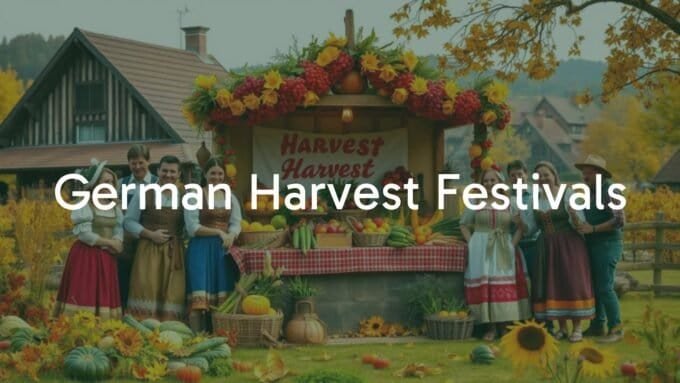There’s no single “best” time to visit Germany because the right moment really depends on your own interests and travel style. Germany is home to lively cities, small traditional towns, fairy-tale castles, and famous wine areas, offering plenty to enjoy every season. Whether you prefer hiking in the sun, exploring Christmas markets, or diving into German culture, you’ll find a season that fits what you want. This guide breaks down each season, giving you a clear look at the weather, crowds, and main events to help you plan a great trip.

Best Time to Visit Germany: At a Glance
Why Time Matters for Your Trip
When you visit Germany can change your trip quite a bit. For example, Christmas market lovers should come in winter, while summer is better if you want to bike, hike, or check out outdoor festivals. The seasons affect the weather, how crowded places get, and what’s open. Knowing this helps you plan so you get the best experience possible.
Travel costs, especially for hotels and airfare, also rise and fall depending on the season. Summer and Christmas are busier and usually cost more, while the months just before and after these times (called shoulder seasons) are often less busy and more affordable. So picking your travel dates carefully can help you save money and avoid crowds.
Germany’s Seasons: What Happens When?
Germany has four clear seasons. The weather is usually what you’d expect in central Europe, with warm summers and cold winters. Spring (March-May) brings fresh greenery, flowers, and warms up slowly, ideal before the main tourist season starts. Summer (June-August) is the busiest, with hot weather and lots of festivals and outdoor fun. Fall (September-November) shows off beautiful autumn leaves, harvest festivals, and famous events like Oktoberfest, with temperatures cooling down as winter approaches.
Winter (December-February) is all about Christmas markets and snowy scenery, especially in the south, plus it’s the time for winter sports. Every season in Germany has its own draw, so you’ll find something different whenever you visit.
The Weather in Germany: What to Know
Different Weather in Different Regions
Because Germany covers a big area, the weather isn’t the same everywhere. The north (near the North and Baltic Seas) is milder, with summers that aren’t too hot or too cold winters. The south (like Bavaria and the Alps) gets the most snow and the coldest winters, making it popular for winter sports. In the east (including Berlin), you’ll find hotter summers and colder winters than in the middle west, while the southwest’s wine region is one of the warmest places in Germany.
Monthly Temperatures: At a Glance
| Month | High Temps (°F) | Weather Highlights |
|---|---|---|
| January | 37-41 | Coldest, often snowy in the south |
| February | 41 | Still cold and wintry |
| March | Up to 48 | Warming up, winter ends |
| April | 50s | Unpredictable, mix of rain and sun |
| May | ~67 | Sunny, great conditions |
| June | 71-77 | Warm, long days, start of summer |
| July | 77-84 | Hottest, rainy spells common |
| August | ~75 | Warm, showers possible |
| September | ~68 | Cooler, autumn begins |
| October | Mid 50s | Cool, often sunny and dry |
| November | 41-45 | Chilly, darker, start of winter |
| December | ~40 | Cold, Christmas markets, some snow |

Guide to Each Season in Germany
Spring (March-May): Fresh Air and Fewer Visitors
Spring is a time for change as Germany turns green and flowers bloom. The days get longer, and it’s still quiet in most tourist places. This makes it easier to enjoy towns and parks without too many people around. Prices for hotels and attractions are usually lower, too.
- Weather: Can be a mix-some days are chilly, others warm, and rain is common, so pack layers.
- Top Spring Events: Leipzig Book Fair (March), Bonn cherry blossoms (late March/early April), Easter markets, and local festivals in May with maypole dancing.
- Best Places: Bonn for cherry blossoms, Berlin for festivals and museums, the Bavarian Alps for reopening hiking trails, Mainau Island for tulips.

Summer (June-August): Warm, Busy, and Full of Festivals
Summer is the most popular time to visit, especially for outdoor activities and festivals. The days are longest, the weather is warm, and there’s a festival just about every week. This is when Germany is liveliest-with outdoor dining, beer gardens, and city parks full of people.
- Weather: Warm to hot, but rain showers and storms are possible, especially in the south. Bring a rain jacket.
- Pros & Cons: Everything’s open and exciting, but expect crowds and higher prices for hotels. Book early.
- Major Events: Bach Festival (June, Leipzig), Schützenfest Hannover (July), Berlin Culture Festival, Freiburg Wine Festival, Frankfurt Apple Wine Festival (August), many local food, music, and art events.
- Outdoor Fun: Perfect for hiking, biking, swimming, and river cruises.

Fall (September-November): Beautiful Colors & Culture
Fall brings cooler weather and great scenery as forests and vineyards change color. It’s quieter than summer, so you can visit tourist sights more comfortably. This season is full of wine festivals and the world-famous Oktoberfest in Munich.
- Weather: September is still pleasant; by October and November, it gets colder and the days shorter.
- Big Events: Oktoberfest (late September-early October, Munich and elsewhere), wine festivals in the Mosel Valley and Rhine, harvest celebrations, Berlin Festival of Lights (October), Germany Unity Day on October 3rd.
- Top Fall Spots: Rhine Valley for vineyards, Black Forest for hiking and colors, Lake Konigssee for peaceful lakeside walks.

Winter (December-February): Christmas Fun & Snow
Winter is cold and days are short, but Christmas markets fill towns with lights, music, and food. Southern Germany becomes a go-to for winter sports like skiing in the Bavarian Alps.
- Weather: Can be very cold, often below freezing, with snow likely in the south and east. Northern cities get less snow.
- Christmas Markets: Best in December-markets in Nuremberg, Dresden, Cologne, Berlin, Leipzig, and others are world famous.
- Winter Sports: Skiing in Garmisch-Partenkirchen, Zugspitze, Black Forest for hiking and cross-country skiing, toboggan runs.
- Other Tips: Many attractions have shorter hours or are closed. Pack heavy winter clothes and good footwear.

Month-by-Month: Events & Highlights
- January: Best for fairy-tale snowy castles, museums in Berlin, and skiing.
- February: Berlin Film Festival, Carnival (mainly Cologne, Mainz, Dusseldorf).
- March: Start of cherry blossoms in Bonn, Leipzig Book Fair, Easter Markets.
- April: Frankfurt Spring Fair, Bonn cherry blossoms peak.
- May: Good weather, fewer crowds, maypole and dance festivals, Stuttgart Frühlingsfest, asparagus festival in Beelitz.
- June: Outdoor activities, Bach Festival, explore Rügen Island beaches, Düsseldorf culture events.
- July: Water sports, picnics, Schützenfest Hannover, Berlin Culture Festival.
- August: Rhine cruises, Romantic Road, Apple Wine Festival in Frankfurt.
- September: Start of autumn, Oktoberfest, grape harvest begins, wine fests.
- October: Fall colors, Black Forest hiking, Unity Day (Oct 3), Festival of Lights in Berlin.
- November: Quieter, start of winter, rustic wine taverns open (Strausswirtschaften/Besenwirtschaften).
- December: Christmas markets, high holiday spirit, SNOW more likely in the south.
Monthly Crowds and Price Guide
| When | Crowds | Hotel Prices | Notes |
|---|---|---|---|
| May-September | High | High | Main tourist season, book ahead |
| March-May, Sep-Nov | Low-Medium | Lower | Best for deals, decent weather |
| Dec (market time) | High | High | Especially Nuremberg, Dresden |
| Jan-Feb | Very low | Lowest | Some places may close or have limited hours |
Best Time for What You Want to Do
City Sights and City Breaks
Visit in spring (April-May) or fall (September-October) for the best weather and fewer tourists. Cities are lively yet not too crowded. Everything is open but lines are shorter, making it easier to explore. Summer is good for those who like busy places and don’t mind paying more. In winter, you’ll find quieter cities and fewer tourists, especially outside Christmas market times-good if you like museums and cozy cafes.
Nature and Outdoors
Summer (June-August) is best for hiking, biking, and water activities-all trails are open and it’s warmest. Spring (April-May) is great for fresh flowers and flowing waterfalls, good light for photos, and comfortable temps for walks. Fall (September-October) is wonderful for colorful leaves, fewer people, and moderate hiking conditions.
Festivals and Culture
Summer is full of festivals (music, traditional, food, etc.), like the Bach Festival and Berlin Culture Festival. Fall is the time for beer and wine fests (Oktoberfest, wine regions). In winter, December is all about Christmas markets; February is Carnival time in certain cities.
Christmas Markets and Holidays
If you want to see the Christmas markets, go at the end of November or December. Cities look magical with lights and festive stalls, and local specialties like gingerbread and mulled wine are everywhere. It gets crowded, but the atmosphere is unbeatable.
Skiing and Winter Sports
Best months: January to March. Head to the Bavarian Alps for skiing, snowboarding, and even tobogganing. Germany’s highest and snowiest ski areas are less crowded than Austria or France, which is a plus for many visitors.
What to Know When Planning
Crowds, Costs, and Hotels by Season
- Summer and Christmas: Most crowded, prices highest, early booking needed.
- Spring and Fall: Fewer crowds and lower prices, especially outside Oktoberfest (when Munich gets very busy and expensive).
- Winter (Jan-Feb): Very quiet, cheapest time, but some places may have shorter hours or be closed.
Cheapest Time to Go
- Best prices are from March to May and October to November (excluding Oktoberfest and before Christmas markets begin).
- January and February are the least expensive for hotels and travel.
Family and Group Travel
- Late spring (May) and early fall (September) are more comfortable, less crowded and good for families or groups.
- Summer is busy and more expensive but fun if you like outdoor activities and festivals. Book family-friendly hotels early.
- Early autumn offers fun harvest festivals and fewer crowds, except during Oktoberfest in Munich.
Common Questions About Visiting Germany
Peak vs. Off-Peak?
Peak season (May-September, and December for Christmas) is best for weather and events but means more crowds and higher costs. Off-peak times (spring, fall, winter outside Christmas) are quieter, more relaxed, and often cheaper-perfect if you don’t want to deal with busy places and want to save money.
Weather’s Impact on Sightseeing?
- Summer: Great for being outside, but be ready for sudden rain. Bring a jacket, plan for both outdoor and indoor things to do.
- Spring/Fall: Weather changes often, so layers are key. Cooler temps can make walking easier than in the summer heat.
- Winter: Cold, snow in the south; sightseeing is often indoors, but Christmas markets make being outside fun for short times.
Final Tips for Picking When to Go to Germany
The best time to travel will be different for everyone. For sun and lots of events, pick summer-even with the crowds, it’s a lively time. If you like peace, good weather, and some local festivals, try May or September. For the best prices, come in winter after New Year. For Christmas magic, December is a must. Whenever you come, Germany is known for being safe and easy to explore. Always pack some layers and comfy walking shoes. Think about the weather in the region you’ll visit-a little planning goes a long way to having a great Germany trip any time of year.









Leave a comment